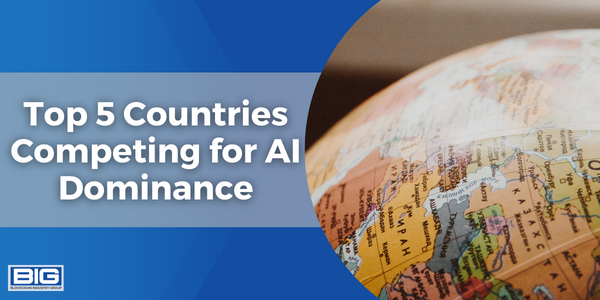
Artificial intelligence (AI) is a rapidly growing field with the potential to transform industries and change the way we live and work. As AI continues to advance, countries around the world are vying for dominance in this critical area of technology. Here are the top 5 countries competing for AI dominance, and the reasons why each is well-positioned to succeed:
1. United States
The United States is home to some of the world’s leading AI research institutions, including the Massachusetts Institute of Technology (MIT) and Stanford University. The country also has a strong foundation in technology and innovation, with Silicon Valley serving as a hub for startup companies and tech giants alike. In addition, the US government has recognized the importance of AI and has invested in initiatives to support the development and deployment of AI technologies.
However, the US also faces some weaknesses in its bid for AI dominance. The country has a high cost of living and a shortage of skilled workers, which can make it difficult for companies to attract and retain top talent. In addition, the US has a patchwork of regulations and policies that can make it difficult for companies to navigate and comply with, which can slow the adoption of new technologies.
2. China
China has emerged as a major player in the AI race, with the government investing heavily in research and development. The country is home to a number of leading AI research institutions, including Tsinghua University and Peking University. In addition, China has a large and growing market for AI technologies, with a large number of tech companies and startups working on AI projects. China’s large population and vast amounts of data also make it an attractive location for AI research and development.
However, China also faces some challenges in its bid for AI dominance. The country has a complex regulatory environment and a lack of transparency, which can make it difficult for companies to operate and innovate. In addition, China’s reliance on foreign technology and expertise leaves it vulnerable to disruption and competition.
3. Japan
Japan is another country that is competing for AI dominance. The country has a strong foundation in technology and innovation, with a number of leading research institutions and companies working on AI projects. Japan also has a highly educated and skilled workforce, which makes it an attractive location for AI research and development.
However, Japan also faces some challenges in its bid for AI dominance. The country has an aging population and a declining birth rate, which could limit its ability to attract and retain top talent in the field of AI. In addition, Japan’s reliance on foreign technology and expertise leaves it vulnerable to disruption and competition.
4. South Korea
South Korea is another country that is competing for AI dominance. The country has a strong foundation in technology and innovation, with a number of leading research institutions and companies working on AI projects. South Korea also has a highly educated and skilled workforce, which makes it an attractive location for AI research and development.
However, South Korea also faces some challenges in its bid for AI dominance. The country has a small domestic market and is heavily reliant on exports, which makes it vulnerable to economic disruption and competition. In addition, South Korea’s regulatory environment and lack of transparency can make it difficult for companies to operate and innovate.
5. Canada
Canada is another country that is competing for AI dominance. The country has a strong foundation in technology and innovation, with a number of leading research institutions and companies working on AI projects. Canada also has a highly educated and skilled workforce, which makes it an attractive location for AI research and development.
Just the Beginning: Apple’s Siri Virtual Assistant
—
Legal Services and the Disruptive Impact of AI
—
Monetizing AI: 10 Strategies for Early Adopters
However, Canada also faces some challenges in its bid for AI dominance. The country has a small domestic market and is heavily reliant on exports, which makes it vulnerable to economic disruption and competition. In addition, Canada’s regulatory environment and lack of transparency can make it difficult for companies to operate and innovate.
In conclusion, these 5 countries are all competing for AI dominance, and each has its own strengths and weaknesses. The US, China, Japan, South Korea, and Canada all have strong foundations in technology and innovation, but they also face challenges such as regulatory barriers, economic vulnerability, and a lack of transparency. As AI continues to advance, these countries will need to address these challenges and find ways to foster innovation and cooperation in order to maintain their competitive edge.



